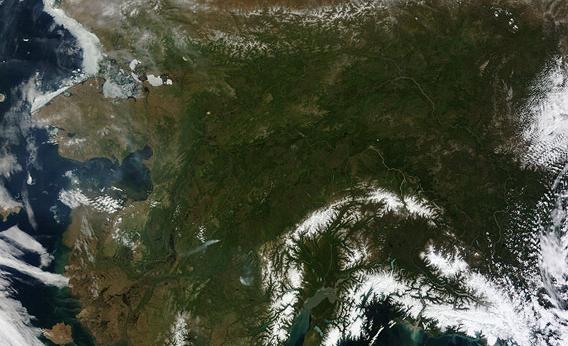Create a free profile to get unlimited access to exclusive videos, sweepstakes, and more!
A Clear View of Alaska—and Maybe Our Future

Alaska, it so happens, is pretty big. If you take Alaska and subtract Texas, the amount left over is still bigger than Texas.
Given that, plus the usual atmospheric conditions, itâs pretty rare to get a picture of the nearly the entire state free of clouds. But thatâs just what NASAâs Terra satellite saw on Monday:
What an amazing shot! The snow-covered mountains in the southeast really stand out, and you can see a forest fire raging farther to the west. I know weâre seeing a huge swath of land, so the scale is hugeâthe picture shows an area about 1,500 kilometers (900 miles) acrossâbut itâs still striking not to see any real signs of human activity here.
Or are we? The reason the state is cloudless is because of a huge high-pressure system squatting over the state. This has also brought record high temperatures to much of the state. This reminds me of the same sort of system thatâs been plaguing Greenland and which caused record ice melting last year.
A new study just came out possibly linking that Greenland system to global warming. Itâs not a direct link; that is, itâs not that things are warmer now so we got more melting. What may be happening is that the changing climate is affecting the pattern of the jet stream, causing warmer high-pressure systems to sit and stay in one place in whatâs called a blocking pattern.
In other words, weather patterns are changing because the climate is changing. The Arctic climate system in particular may be undergoing a rapid evolution due to changing conditions there; loss of sea ice (which exposes darker water, increasing the amount of heat absorbed from sunlight), the wobbling of the jet stream, and more subtle variations are playing havoc with the normal weather.
The melt in Greenland and the high temperatures in Alaska may be more signsâlike we needed moreâof the reality of climate change. Even scarier is the fact that the climate models used before didnât predict this sort of thing. The climate is very complex, and itâs hard to model it accurately. This is well-known and is why itâs so hard to make long-term predictions.
But before the deniers crow that climatologists donât know what theyâre doing, note this well: The predictions made using these models almost always seem to underestimate the effects of climate change. Thatâs true in this case, too. So itâs not that the models are wrong and therefore climate change doesnât exist. Itâs that the models arenât perfect, and itâs looking like things are worse than we thought.
Weâll know better in the next couple of years, as more data are taken of these blocking systems. That view of Alaska is beautiful, to be sure, but with a notion of what it may really mean, ironically, itâs also chilling.
(Note: There is some noise that President Obama, finally, after five years in office, may soon try to take some action on this issue. I hope he does, because Iâm tired of hearing talk about it. I want to see progress.)


























